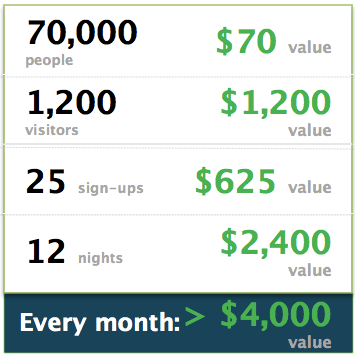With Social Media there has evolved a new expression for the ideal customer. This expression is Superfans.
Who are they? Where are they? Why should Hotels connect with them?
They are the customers that get completely involved with your brand, and will go out of their way stay with your Hotel Brand. Up until now Hotels has used their reward programs to identify these customers.
Today we find these customer on Facebook, Twitter, LinkedIn, Google+, YouTube and some write blog post about their experiences.
Be the first to know, sign up here and stay up to date with our latest revenue management news, updates and special offers
We want to create happy returning guests, that will share the excitement of their Hotel Experience and refer their friends and network back to your Hotel.
Social Media brings us closer to these customers. And we now have a great new tool to identify their wants and needs.
First Step: Relationship Marketing
Relationship Marketing consists of some of the traditional Hotel values like Customer Service, Customer Care and Customer Relationship. The new element that is added with Social Media is Customer Engagement.
It all starts with Serve Your Guests. Deliver more then the intangible values guest anticipate they will receive.
On Facebook one of the most effective ways to engage with Customer is through contests. When chose this form of engagement make sure you familiarize yourself with Facebook’s Promotion Guidelines. Facebook’s New Fan page timeline is gearing towards more customer engagements.
The purpose of contests is to capture engagement leads. Remember this is about building a relationship with the customer. So make sure you have some follow up program set up. These follow up programs should focus on how you can add value when they return back to your Facebook Fan Page.
On Twitter you can engage on various hospitality #hashtag discussions or events. Here you can invite your Superfans to launch a special featured Social Media Campaign. Four Seasons Twitter Campaign is a brilliant example that many Hotels can benefit from modeling.
With LinkeIn you should identify groups that focus on relevant up-to-date topics for your Hotel. Hotel Strategies is one of the groups I manage on LinkedIn where we focus on a variety of Topics that is related to Social Media and customer engagement.
Second Step: Response Strategy
Response we define as a output that we can measure. If customer provide some type of response about your Hotel, you can correct, adjust or verify the information. You can also control and measure the feedback.
– If the information is misleading you can correct it
– If the information contains some errors then you can adjust it
– If the information is correct you can verify it
Traditionally Hotels has applied this type of response with Customer Service.
Either we chose to utilize Social Media or not the Hotel Experience very often start long before the customer has arrived and checked in at the Hotel. The Experience starts when it is identified they will travel either for leisure or business. From there the research process starts.
Catch your customers in advance with an application that focus on various touch points in the booking process. Flip.to (*disclaimer* I am a partner with Flip.to) provides Hotels with a unique tool that allows your to capture the customer during their research process.
In this case the Hotels verify that one of their customers was upgraded to one of their spacious suite. This also add value to the Hotels Relationship Marketing strategy. And as you also see here there is Facebook Connect touch point on the Hotels Website. This add a new dimension to the booking.
The Customer will be encourage to book based on a verified response from a previous satisfied customer, and then given the opportunity get their own complimentary upgrade that they now can share with their Facebook Network.
With Customer Engagement you will focus on Serve Your Guets, and you will apply these strategies in the front end.
– If the information is engaging you can share it
This is a new touch point value that adds a hole new dimension to the Hotel experience. The clue is to have a program like Flip.to in place that will verify the information both from the customer perspective and from the Hotel perspective.
Step 3: Reputation Management
Reputation Management is the principle of tracking the opinions your customers have about your Hotels products and services, and others reactions to those opinions.
Flip.to identify valuable touch points that Hotels can measure. Engagement is one part of the process that Hotels want to track. This will allow you to identify the trigger points that converts into bookings.
When it comes to the end of the day what matters to most Hoteliers is booking conversions. ROI – Return Of Influence is what we really.
This is where your Hotels Superfans really comes into play. For a typical 200-room Hotel, Flip.to average 250 posts shared by guest with their Social Networks.
As the illustration shows this will average an outreach of 70,000 network connection. This converts to 1200 unique visitors to your Hotels website. And result in 25 signups. The end result will be minimum 12 nights booked per month.
And Flip.to has made it easy for your Hotels Superfan to share their experience with their Social Networks.
If the feedback is positive it takes the Hotel guests to a new screen where they can share the good news with their Social Network of choice.
And to make the Reputation Management Circle complete your Hotel guest is encouraged to leave a review with TripAdvisor.
And your Hotel will be provided tools that let you monitor where your guests shared information about your Hotel.
Summary
To achieve a positive outcome from these 3 easy steps require that your Hotel puts in place a Social Media Strategy. And then follow up with weekly status for each of the steps. Then add one extra step to process.
Bonus Step: Rinse/Repeat
Traditional Marketing strategies is normally a static process based on demographic data and know variables for your targeted market segment. Social Media Marketing is a dynamic process where you adapt and change to your customers wants and needs.
With the right tools in place you are equipped to capture new trends and market segments.













